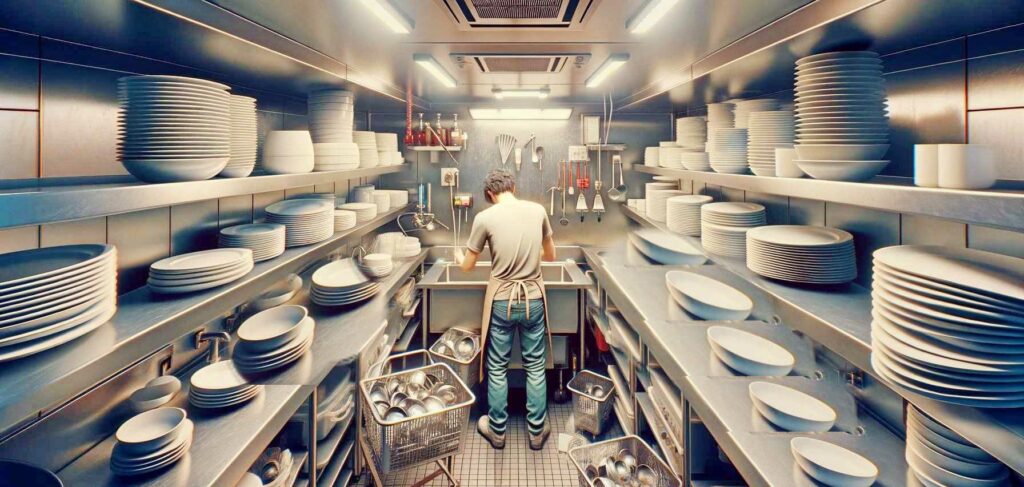Scrap Collector System Keeps Smaller Dish Areas Organized
The upside to working in a smaller commercial kitchen and dishroom is that there are no wasted steps. You’re never more than a few feet away from something that you need.
But the downside is that space is at a premium with a smaller footprint and if there’s any clutter, then things can quickly turn chaotic.
When space is limited, thoughtful planning and strategic design can help things run smoothly. Organization is the best way to keep efficiency high in a smaller commercial kitchen.
To prevent employees from bumping into each other, maintaining a clean and efficient commercial dish room is a necessity.
Utilizing Every Inch of Space in the Place
Counter space in a smaller commercial kitchen is at a premium. Separate your kitchen into specific zones and train your workers to stay within their zones.
Storage often takes up quite a bit of space. To maximize this, consider using tall shelves for ingredients. Much like the storage method for cold food, put some careful thought into where things should be stored.
Lighter items such as spices should go on top. Easier to get up and down carefully. Heavier items such as liquids and sauces should go on the bottom. Each of these should be in a sealed container. If there is a leak, the rest of the pantry remains safe with your liquids on the bottom shelf.
For commonly used items such as salt, sugar, and flour, consider using under-the-counter bins. Spices should always be nearby so chefs don’t have to waste time retrieving them from the pantry. It also cuts down on having to constantly refill different sizes of shakers. While bins need to be regularly cleaned, it increases efficiency in your kitchen’s output.
Peg boards also allow cooks to keep their utensils out in the open and not stuffed into a drawer. This allows them to cook with efficiency and means safer storage methods. Knives are kept sheathed in the open and do not run a risk of slicing fingers in drawers.
Floorplans Mean Everything
When designing a smaller commercial kitchen, make sure to analyze your square footage. Keep an eye on your layout and appliance placement.
If you are moving into an already existing space, plan out where the best places to put appliances would be based on electrical outlets and workflow. Do a walkthrough of the space to imagine various employee roles. Have a trial run through with your employees to get their feedback.
Having the Right Tools for the Trade
Every commercial kitchen needs certain appliances. Ice-makers, ovens, etc. Many of these can be big and bulky. When designing a smaller commercial kitchen, consider downsizing appliances.
Items like undercounter ice-makers or toaster ovens leave more room to maneuver. This opens up more space for meal prep, storage, or plated meals. It also prevents employees from having to move large appliances when cleaning.
Strategic storage space is necessary when it comes to a smaller commercial kitchen.
Vertical Space Optimization
One effective strategy is to maximize the use of vertical space. This can include installing shelves and racks that go up to the ceiling, using hanging pot racks, or employing stackable storage solutions.
Vertical storage not only frees up floor space but also makes it easier to organize and locate items quickly.
Multipurpose Equipment and Furniture
Investing in multipurpose equipment can significantly save space. For example, equipment that combines several functions, like a combination oven, reduces the need for multiple single-function appliances.
Furniture that can be folded or stacked when not in use can provide flexibility in tight spaces.
Efficient Layout Planning
The layout of a kitchen and dish room should facilitate a smooth workflow. This might involve positioning the dishwashing area close to the storage for clean dishes to minimize movement. Arrange cooking equipment in a logical sequence that follows the cooking process to enhance efficiency.
Decluttering and Organization
Regular decluttering is essential in maintaining an optimized space. This involves discarding unused or rarely used items and organizing the remaining items in an orderly manner.
Implementing an efficient storage system with clear labels can help staff find what they need without wasting time.
Customized Solutions
Sometimes, standard equipment and storage solutions may not be the best fit for a particular space. In such cases, investing in customized solutions that are specifically designed to fit the available space can be more beneficial.
This could include custom-built shelving or specially designed equipment that fits into awkward spaces or investing in a scrap collector system to prevent drain clogs from food solids.
Our Scrap Collector System Keeps Smaller Dish Areas Organized
Optimizing space in smaller commercial kitchens and dish rooms is about making smart choices in layout, storage, and equipment. By understanding the specific needs of the space and employing creative solutions, it’s possible to create a highly functional and efficient work area, even when space is limited.
The goal is to enhance the workflow and productivity without compromising on safety or functionality.
The Drain Strainer™ can help you avoid issues with what gets put down your 3 compartment sinks. No matter how much you focus on employee training, short cuts are always going to be taken and items are going to be put down your foodservice disposer that can harm it.
If you want to avoid issues with clogged grease traps or garbage grinders that are leaking or have burned out motors, The Drain Strainer™ is an effective and affordable scrap collector system that doesn’t require the use of water or electricity.
Invented by a former restaurant owner, The Drain Strainer™ can eliminate issues with mangled silverware or dangers from employees putting their hands down the commercial garbage disposal trying to clear out a clog.
Click here to find out more about how our scrap collector system can keep your restaurant floor drains free from clogs.
Let The Drain Strainer™ keep your 3 compartment sinks running smoothly by capturing food solids and avoiding any drain problems.

